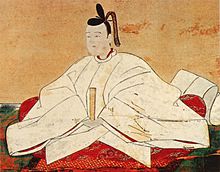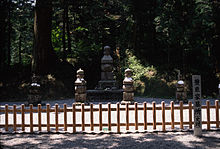Toyotomi Hideyori
This article needs additional citations for verification. (September 2007) |



Toyotomi Hideyori (豊臣 秀頼, September 8, 1593 – June 5, 1615) was the son and designated successor of Toyotomi Hideyoshi, the general who first united all of Japan. His mother, Yodo-dono, was the niece of Oda Nobunaga.
When Hideyoshi died in 1598, the five regents he had appointed to rule in Hideyori's place began jockeying amongst themselves for power. Tokugawa Ieyasu seized control in 1600, after his victory over the others at the Battle of Sekigahara. Hideyori's arranged marriage to Senhime, the seven-year-old granddaughter of Ieyasu, was designed to mitigate Toyotomi clan dissension and plotting.[1] In this period, the eight-year-old boy practiced calligraphy with phrases wishing for peace throughout the world.[2] However, Ieyasu continued to view the young Hideyori as a potential threat.
Tokugawa forces attacked Hideyori in the Siege of Osaka in the winter of 1614. The attack failed, but Hideyori was induced to sign a truce and dismantle the defenses of his stronghold Osaka Castle.
In April 1615, Ieyasu received word that Toyotomi Hideyori was gathering even more troops than in the previous November, and that he was trying to stop the filling of the moat of Osaka Castle. Toyotomi forces (often called the Western Army) began to attack contingents of the Shogun's forces (the Eastern Army) near Osaka. On June 5, 1615. As Toyotomi's forces began to lose the battle, a smaller force led directly by Hideyori sallied forth from Osaka Castle too late, and was chased right back into the castle by the advancing enemies. There was no time to set up a proper defense of the castle, and it was soon set ablaze and pummeled by artillery fire. Hideyori and his mother committed seppuku, and the final major uprising against Tokugawa rule for another 250 or so years was put to an end. His widow remarried but later became a Buddhist nun.
Hideyori's son Kunimatsu (age 8) was captured and beheaded; his daughter was sent to Tōkei-ji, a convent in Kamakura, where she later became the abbess Tenshū-ni.
Notes
- ^ Watsky, Andrew Mark. (2004). Chikubushima: Deploying the Sacred Arts in Momoyama Japan, p. 199., p. 199, at Google Books
- ^ Narayan, R. K. "Speaking Of Books: Tea With Kawabata; Kawabata," New York Times. September 14, 1969.
References
- Morita Kyōji 森田恭二 (2005). Higeki no hiirō Toyotomi Hideyori 悲劇のヒーロー豊臣秀頼. Osaka: Izumi Shoin 和泉書院.
- Watsky, Andrew Mark. (2004). Chikubushima: Deploying the Sacred Arts in Momoyama Japan. Seattle: University of Washington Press. 10-ISBN 0-295-98327-2; 13-ISBN 978-0-295-98327-1; OCLC 52127871
